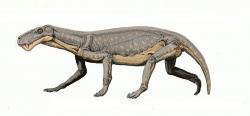With the diversity of life on Earth, and its ability to exploit every niche, you would think planet could bounce back from a devastating extinction event. Or maybe not. According to researchers from the University of Bristol, life took a full 30 million years to recover from the Permian extinction.
The poor animals alive during the Permian extinctions were struck by three waves of disaster. The largest of these happened at the boundary between the Permian and Triassic periods around 251 million years ago. Geologists think it was caused by large-scale volcanism in Russia which produced the ‘Siberian Traps’ – vast regions of lava 200,000 square km (77,000 square miles) in area. In a geologic heartbeat, 90% of all life on Earth was completely wiped out: insects, planets, marine animals, amphibians, and reptiles… everything. Life never got so close to being completely wiped off the face of the Earth.
Life did bounce back quickly, but diversity didn’t. Instead of the rich ecosystems we see today, very opportunistic creatures filled the empty spaces left behind by the extinction. One example is Lystrosaurus, a hardy herbivore the size of a pig.
Sarda Sahney and Professor Michael Benton at the University of Bristol looked at the recovery of animals like amphibians and reptiles. Although these creatures did make a recovery quickly, it took 30 million years for the number of animals and their diversity to match the pre-extinction levels.
Sahney said: “Our research shows that after a major ecological crisis, recovery takes a very long time. So although we have not yet witnessed anything like the level of the extinction that occurred at the end of the Permian, we should nevertheless bear in mind that ecosystems take a very long time to fully recover.�
This is an important thought to consider now that we’re in one of the most rapid periods of species loss in history.
Original Source: University of Bristol


Another candidate for the Permian Extinction is an extraterrestrial event. A 200km crater has recently been found in Antarctica. The impact may have been the cause of the Siberian Traps.
Yes, that has always puzzeled me: why is it that it is assumed to be meteor impace OR vulcanism? It seems to me that a large impact would cause the Earth to ring like a bell – pressure waves traveling and bouncing throughout the bulk of the Earth. Any weak spots – lines, etc. in the brittle crust should experience severe stresses – quite possibly sufficient to cause extensive volcanic action, and/or massive earth-quakes.
What is significant is that life did not come back the same as it was before, which would only be logical to expect. However, it came back and evolved very differently. It seems like the thriving layer of life before the disaster was in the way of further development, so therefore calamitous extinction actually becomes a necessary part of the evolution process. Which follows the most amazing phenomena of all – that the volcanic or asteroidal calamities were not chance-based, but completely subservient to the biologic progression on the planet. In other words, the needs of bio-evolution and now psycho-evolution drive the material world, not the other way around. Matter is merely a limiting form factor to the bio-psych driver. The universe is here to produce and serve transcendant human consciousness.
So what characterized the dinosaur era? It seems to have been the era of “how big can a warm-blooded organism get”? Size truly was the sole dominating and determining factor of life for an eon. Intellect was repressed and stifled. There was no way for biologic life to evolve past this layer without a geologic force of destruction to intervene. After the disaster, size suddenly was no longer the determining factor – the “opportunistic” life forms thrived and pure size was never again able to reassert itself. Some other driver took over and repressed size development – what? Some critical opportunism of smallness, which contained the potential for bipedalism, tools, symbolic language and reflective consciousness.